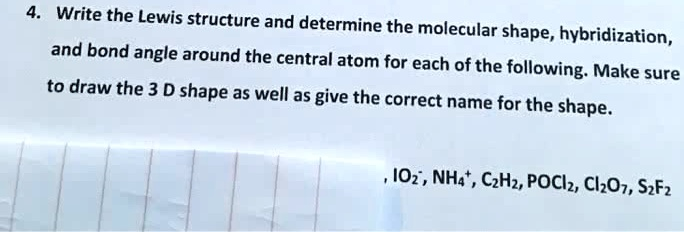. Write the Lewis structure and determine the molecular shape, hybridization, and bond angle around the central atom for each of the following.

The Correct Answer and Explanation is:
To answer this question, let’s break down each of the compounds one by one.
- IO₂⁻ (Hypoiodite Ion):
- Lewis Structure: Iodine (I) is the central atom, and it is bonded to two oxygen (O) atoms. One of the oxygen atoms has a negative charge, indicating an extra electron.
- Molecular Shape: The shape is bent or V-shaped due to the lone pairs on the iodine atom.
- Hybridization: The iodine atom undergoes sp² hybridization because it forms two bonds with oxygens and has one lone pair.
- Bond Angle: The bond angle is about 120°.
- NH₄⁺ (Ammonium Ion):
- Lewis Structure: Nitrogen (N) is the central atom, bonded to four hydrogen atoms.
- Molecular Shape: The shape is tetrahedral.
- Hybridization: The nitrogen atom undergoes sp³ hybridization because it has four bonding pairs and no lone pairs.
- Bond Angle: The bond angles are 109.5°.
- C₂H₂ (Acetylene):
- Lewis Structure: Each carbon (C) is triple-bonded to the other carbon and single-bonded to a hydrogen (H) atom.
- Molecular Shape: The shape around each carbon is linear.
- Hybridization: Each carbon atom undergoes sp hybridization, as each carbon has two regions of electron density (one triple bond and one single bond).
- Bond Angle: The bond angle is 180°.
- POCl₂ (Phosphoryl Chloride):
- Lewis Structure: Phosphorus (P) is the central atom, bonded to two chlorine (Cl) atoms and one oxygen (O) atom. The phosphorus has one lone pair.
- Molecular Shape: The shape is trigonal pyramidal due to the lone pair on the phosphorus atom.
- Hybridization: The phosphorus atom undergoes sp³ hybridization.
- Bond Angle: The bond angles are less than 109.5° due to the lone pair.
- Cl₂O₇ (Dichlorine Heptoxide):
- Lewis Structure: Two chlorine (Cl) atoms are each bonded to three oxygen atoms, and the chlorine atoms are connected by a single oxygen atom.
- Molecular Shape: The shape is bent or V-shaped around the chlorine atoms.
- Hybridization: The chlorine atoms undergo sp³ hybridization.
- Bond Angle: The bond angles are approximately 104.5°.
- S₂F₂ (Disulfur Difluoride):
- Lewis Structure: Each sulfur (S) atom is bonded to one fluorine (F) atom and the other sulfur atom.
- Molecular Shape: The shape is linear.
- Hybridization: The sulfur atoms undergo sp hybridization.
- Bond Angle: The bond angle is 180°.
Each of these molecules has unique shapes based on their bonding and electron pair geometry. The bond angles and hybridization are determined by the regions of electron density around the central atom, following VSEPR theory.
